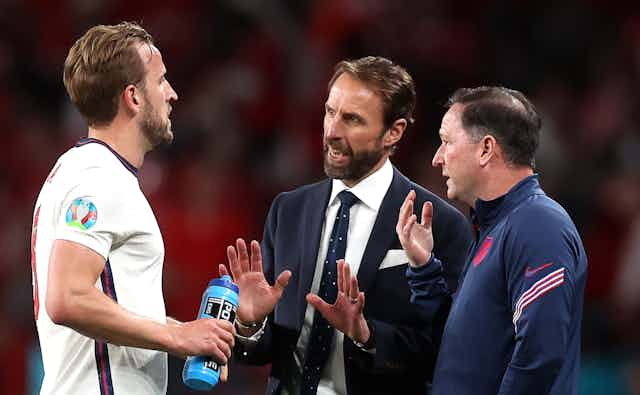Over the course of England’s journey to the Euro 2020 final, one of the most fascinating plays has been happening just off the pitch. Whenever the TV camera cuts to the team’s manager Gareth Southgate, he is occasionally seen standing alone on the edge of the field, urging his team on.
You can listen to more articles from The Conversation, narrated by Noa, here.
But most of the time he is deep in conversation with his assistant Steve Holland. It is regular proof of how Southgate approaches key decisions and planning.
Those plans, and England’s progress in the competition, have led to Southgate’s style of management and leadership being widely celebrated. Some point out his supportive approach to players, his focus on creating a positive atmosphere, and his willingness to listen.
He has also been praised for drawing on knowledge and experience from outside the world of football. Others highlight his own experiences as a player, and indeed, research does suggest that on the whole, it is ex-players who tend to make the better football managers.
Another interesting aspect is that Southgate treats management itself as a team sport. Instead of being the sole authority figure, he is part of a larger team of decision makers, all of whom have an influence on the squad of players.
Southgate is far from alone in this approach. Most major sports teams now involve a large team of managers and assistants and a similar kind of expansion has become apparent in the business world too.
Sometimes this increasingly large cadre of managers serves primarily to shield a leader from the harsh winds of reality and external criticism. But good leaders use their management teams as a way to expand the availability of skills and perspectives. Indeed, Southgate has used his as a way of bringing in a wide range of expertise in areas including tactics, physical performance and nutrition.
Southgate also practises what is known as “shared” or “distributed” leadership. This is when the responsibility of managing and directing a team is not heaped on the shoulders of a single individual. Instead, it is shared around, distributed between the wider management team and also among the players.
Research has found that patterns of shared leadership are quite common in sports teams. And outside of sport, it also seems that teams which share leadership and decision making tend to perform better.
Team goals
In some large firms, rather than leadership being vested in a single managing partner, it is often distributed among a group of highly influential people. Recent research has found that collective leadership is vital in driving large scale and change in these organisations.

Southgate’s approach to leadership reflects wider changes within football and society. A recent study of English football culture points to a shift away from what the authors term “Beckhamisation”, after the former England captain and Manchester United star player David Beckham – a popular and instantly recognisable symbol of that period of football history (though, it is not suggested the culture was his creation).
During the 1990s, the study claims, this “Beckhamisation” saw high octane management practices imported from the corporate world into football. Individual talent was highly valued, generously rewarded and strictly managed – but this celebration and focus eventually bred a culture of toxic individualism.
In recent years, this has been replaced by “Southgatism”, a leadership style which that study describes as “modest, self-deprecating, down to earth, diverse and progressive”.
Southgate’s style of leadership (and perhaps future success) is likely to remain the subject of much discussion. Like many iconic leaders, he will be widely imitated, so expect to see plenty of middle managers showing up to work wearing waist coats and thin ties. But hopefully, they will also seek to copy his serious approach to shared leadership and collective responsibility.

